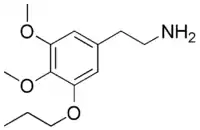Metaproscaline
Metaproscaline, or 3,4-dimethoxy-5-propoxyphenethylamine, is a lesser-known psychedelic drug. It is an analog of proscaline. Metaproscaline was first synthesized by Alexander Shulgin. In his book PiHKAL (Phenethylamines i Have Known And Loved), the dosage and the duration are unknown. Metaproscaline produces few to no effects. Very little data exists about the pharmacological properties, metabolism, and toxicity of metaproscaline.
 | |
| Names | |
|---|---|
| IUPAC name
2-(3,4-dimethoxy-5-propoxyphenyl)ethanamine | |
| Identifiers | |
CAS Number |
|
3D model (JSmol) |
|
| ChEMBL | |
| ChemSpider | |
PubChem CID |
|
| UNII | |
CompTox Dashboard (EPA) |
|
InChI
| |
SMILES
| |
| Properties | |
Chemical formula |
C13H21NO3 |
| Molar mass | 239.311 g/mol |
Except where otherwise noted, data are given for materials in their standard state (at 25 °C [77 °F], 100 kPa).
Infobox references | |
See also
This article is issued from Wikipedia. The text is licensed under Creative Commons - Attribution - Sharealike. Additional terms may apply for the media files.